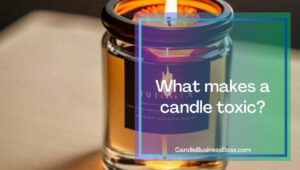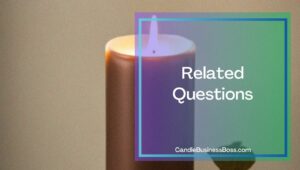Keeping you and your loved ones safe and healthy is a massive priority, especially in our day and age. As you burn candles in your home, though, you may expect them to be safe. What happens when they’re not? Do you know how to spot a non-toxic candle?
Which Candles Are Not Toxic?
Non-toxic candles are made with natural waxes, like beeswax or soy wax, and are fragranced by an all-natural essential oil. When burning, they typically use a wood wick or cotton wick. Candles that are considered toxic include paraffin candles with lead core wicks and synthetic fragrances, as they can release cancer-causing toxins into the air.
Before you consider throwing out all your candles and starting over, there are ways to tell what candles are toxic or non-toxic. Read on to find out more about what makes a candle toxic and what you should be buying if you don’t want those carcinogens in the air around you and your family.
What makes a candle toxic?
When determining the best candles to burn that are non-toxic, you must know what makes a candle toxic in the first place. When you burn a candle, you could be putting into the air lead emissions, carcinogenic material, or other things that could cause you harm.
There are several issues that make a candle toxic. One of this is the type of wax. Most candles on the market right now are made of paraffin wax, which is created through the petroleum refinement process. While a cheap option when making candles, burning paraffin can actually leave carcinogenic soot in your air, which can cause respiratory issues or exacerbate issues you already have with your lungs or heart.

Even if it is just sitting on your shelf, the paraffin wax can release volatile organic compounds into the air. Phthalates in these chemicals can cause cancer, weight gain, hormone problems, and shift your mood. Once it starts to burn, it can release chemicals like formaldehyde, benzene, and acetone.
If that wasn’t already enough, paraffin wax’s soot can cause damage to your house and electronics.
If you a burning a candle with a synthetic fragrance oil rather than a natural one, you may find that those candles are releasing carcinogenic particles, too.
Another issue are candle wicks. If you are burning an old candle, you may find that your candles have lead-core wicks. Because fragrance oils make waxes softer, a more rigid wick stands straighter in the candle. This issue, though, only affects candles older than 2003, which is when they were banned. Check the labels on your candles—if you find yourself pulling a candle out from before then, your candle wick could put five times the amount of lead that is hazardous for children into the air in your home, according to the Consumer Product Safety Commission. Lead exposure can lead to behavioral problems, learning disabilities, and more.
To check your candle for a lead wick, if you have already started burning it, you should check to see if it has a metal core. If it is an unburned candle, rub the tip of the wick on a piece of paper. If it leaves a mark, it also has a metal core. Get rid of these candles to prevent any lead exposure.
What are the pros and cons of coconut wax?
What alternatives can I look for?
Avoiding paraffin wax in your candles is one of the easiest ways to burn non-toxic candles in your home. Many candle making businesses have been shifting to more natural waxes, so you’re in luck—you will have a plethora of choices.
One of the best choices when it comes to candles is a natural wax blend that use a cotton wick. Note that if you’re looking for beeswax, make sure your candle is marked 100 percent beeswax—many manufacturers will mix beeswax with paraffin to help reduce costs.

When you’re looking for a candle without a lead wick, most new candles should include that on their label. You can also reduce soot from these candles by trimming your wicks down to about an eighth of an inch and burn them in a place without any breezes.
Natural wicks like wooden wicks are also a fantastic option for swapping out your toxic candles to non-toxic. Not only do they not have the carcinogens that the lead wicks do, but they do not produce any soot and actually give off negative ions. Negatively charged ions can attract those positively charged particles—which usually included dust, pollen, and other allergens—out of the air. Others believe that negative ions can actually help alleviate mood problems and help de-stress you in the meantime. When shopping for candles, focus on finding one with a natural cotton wick that is unbleached for best results.
Candles using essential oils as their fragrances is also a way to find an alternative. When you look at fragrances, though, make sure they are listing that they are using essential oils—sometimes they will say “fine fragrance” or “phthalate-free fragrance.” This can usually mean that they’re a blend of synthetic fragrances—which means these too can be toxic. Focus on finding 100 percent natural essential oils on candle labels. If they can’t share that information, it is probably a synthetic fragrance.
If you are looking to make your own all-natural candles, following these guidelines are easy. Make sure to use unbleached cotton wicks, 100 percent soy wax or beeswax, and essential oils that are 100 percent all natural.
What are some natural brands that I can shop for non-toxic candles?
Because the trend of safe, non-toxic candles is here to stay, many candle makers are focused on their company’s products being all natural, non-toxic, and environmentally friendly. If you’re looking to purchase some all-natural candles, the following companies are a great place to start.
The Beeswax Co. sells out of Texas, and you don’t just have to buy their ready-made candles there—they also sell pure beeswax in many different amounts.
Beverly Bees is a company out of Salem, Massachusetts who doesn’t just offer beeswax candles—you can literally purchase your own beehive or call for local bee removal if you live close by.
Bookend Candle Co. out of Ypsilanti, Michigan is a one-woman business that sells vegan products in reusable jars.
Brooklyn Candle Studio creates luxury candles at accessible prices—while using 100 percent American grown soy wax and lead-free cotton wicks.
Happy Flame is an Australian company that even makes sure its packaging is compostable.
PF Candle Co. uses 100 percent domestically grown soy wax, and all their candles are vegan, cruelty-free, and phthalate-free.
Welch Candle Company sells 100 percent beeswax candles with a focus on keeping all their candles non-toxic. They also give 10 percent of their profits to a local non-profit fighting against human trafficking.
The best way to keep toxic candles out of your home is simply looking at the ingredients list. Candle makers should be sharing their ingredients on their candles or on their website—and if they don’t, steer clear, as you don’t know what could be inside those candles. Stay aware of what you should look for in the type of wax, wick, and fragrance oils, and you too can keep your family and household safe from any harmful carcinogens in less than natural candles.
Related Questions

What is the best wax for scented candles?
When you are purchasing or buying candles, focusing on either paraffin wax or a natural oil wax are the best for dispersing scents. Paraffin wax continues to be the cheapest option, but because it is made through the petroleum refinement process, it can be toxic. Using a natural wax like palm wax or soy wax can help mitigate that concern, can also come with a light natural scent and may be harder to work with.
Is synthetic oil or essential oil better for my candles?
Choosing a type of fragrance oil for your candle comes down to personal preference. Synthetic fragrance oils tend to be cheaper, but they can be toxic as well. Essential oils are much more expensive than synthetic candle fragrances, but you have the benefit of them being all natural and non-toxic.
What kinds of candles will crackle when burning?
Candles crackle because they have a particular type of wick. Wooden wicks in candles create that crackling noise, and those wicks work best with soy wax. Most natural candles with wooden wicks and made of soy wax will crackle when they are burned.
What makes wooden wicks best or worst for candles?
There are many advantages and disadvantages to burning a wooden wick. Because if the construction of the wick, sometimes they are easily extinguished with a slight breeze and are hard to relight once they are put out. They burn cleaner than most other candles and can help clean the air by producing negative ions. They last much longer than other types of wicks, and reportedly burn better and more efficiently, as they are larger and have more contact with the wax.
Considering starting your own candle making business. Click this link to checkout my startup documents here.
Please note that the contents of this blog are for informational and entertainment purposes only and should not be construed as legal advice. Any action taken based on the information provided in this blog is solely at your own risk. Additionally, all images used in this blog are generated under the CC0 license of Creative Commons, which means they are free to use for any purpose without attribution.

Meet Shawn Chun: Entrepreneur and Candle Business Fan.
I’m a happy individual who happens to be an entrepreneur. I have owned several types of businesses in my life from a coffee shop to an import and export business to an online review business plus a few more and now I create online candle business resources for those interested in starting new ventures. It’s demanding work but I love it. I do it for those passionate about their business and their goals. That’s why when I meet a candle business owner at a craft fair, farmers market, retail location or anywhere else I see myself. I know how hard the struggle is to obtain and retain clients, finding good employees all while trying to stay competitive. That’s why I created Candle Business Boss: I want to help candle business owners like you build a thriving business that brings you endless joy and supports your ideal lifestyle.

